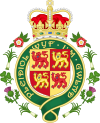
Back Etholaethau a Rhanbarthau etholiadol Senedd Cymru Welsh Circonscriptions et régions électorales du Senedd French Senedd constituencies and electoral regions SIMPLE
| Senedd constituencies and electoral regions | |
|---|---|
| |
 Map of the 40 constituencies (left side) and the 5 electoral regions (right side) of the Senedd in Wales | |
| Category | Electoral district |
| Location | Wales |
| Created by | Government of Wales Act 1998 |
| Created |
|
| Number | 40 constituencies 5 regions[a] (as of 2021) |
| Populations | Constituency: 43,125 (Arfon) - 81,366 (Cardiff South and Penarth) Region: 413,569 (South Wales West) - 523,096 (South Wales Central) |
| Government | |
| This article is part of a series within the Politics of the United Kingdom on the |
| Politics of Wales |
|---|
 |
The Senedd constituencies and electoral regions (Welsh: Etholaethau a Rhanbarthau etholiadol Senedd Cymru)[i] are the electoral districts used to elect members of the Senedd (MS; Welsh: Aelodau'r Senedd or AS) to the Senedd (Welsh Parliament; Welsh: Senedd Cymru), and have been used in some form since the first election of the then National Assembly for Wales in 1999. New boundaries were introduced for the 2007 elections and currently consist of forty constituencies and five regions. The five electoral regions are: Mid and West Wales, North Wales, South Wales Central, South Wales East, and South Wales West, with the forty constituencies listed below.[4] Voting last took place in all districts in the 2021 Senedd election, and is not used for local government.
The constituencies were created through the Government of Wales Act 1998, with the boundaries of the Welsh constituencies of the House of Commons of the Parliament of the United Kingdom (Westminster), as they were in 1999. The new boundaries were also used for the 2010 United Kingdom general election. Therefore, between the 2007 Assembly election and the 2010 United Kingdom general election, the two sets of constituencies, Assembly and Westminster, had differing boundaries. The Parliamentary Voting System and Constituencies Act 2011, unlinked the two sets of constituencies, meaning any changes to one set, no longer affect the other. This has allowed for differing proposals for constituencies in Wales, with separate proposals for an increase in Senedd seats and a decrease in UK Parliament constituencies in Wales.[5]
Senedd constituencies are grouped into electoral regions consisting of between seven and nine constituencies. An additional member system is used to elect four additional Members of the Senedd from each region, in addition to the MSs elected by the constituencies. The Electoral Regions boundaries were based upon the pre-1999 European Parliament constituencies. At each general election of the Senedd, each elector has two votes, one constituency vote and one regional party-list vote. Each constituency elects one Member by the first past the post (single-member district plurality, SMDP) system, and the additional Senedd seats are filled from regional closed party lists, under the D'Hondt method, with constituency results being taken into account, to produce a degree of proportional representation for each region. Altogether, the sixty Members of the Senedd are elected from the forty constituencies and five electoral regions, creating a Senedd of forty constituency MSs and twenty additional MSs. Every constituent is represented by one constituency member and four regional members.
Cite error: There are <ref group=lower-alpha> tags or {{efn}} templates on this page, but the references will not show without a {{reflist|group=lower-alpha}} template or {{notelist}} template (see the help page).
- ^ "Senedd and Elections (Wales) Act 2020". legislation.gov.uk. Retrieved 8 July 2021.
- ^ "Government of Wales Act 2006". legislation.gov.uk. Retrieved 11 July 2021.
- ^ Perks, William. "Data for the Senedd Cymru constituency areas: 2021". gov.wales. Senedd Research. Retrieved 8 July 2021.
- ^ "The Parliamentary Constituencies and Assembly Electoral Regions (Wales) Order 2006". www.opsi.gov.uk.
- ^ "Parliamentary Voting System and Constituencies Act 2011". legislation.gov.uk. UK Parliament.
Cite error: There are <ref group=lower-roman> tags or {{efn-lr}} templates on this page, but the references will not show without a {{reflist|group=lower-roman}} template or {{notelist-lr}} template (see the help page).